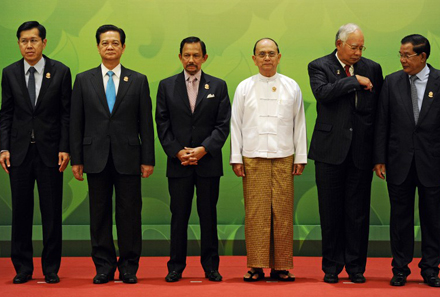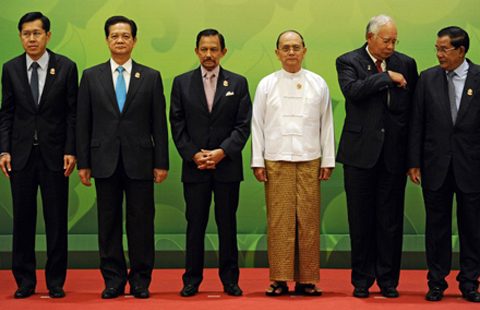
No longer the odd man out. Myanmar President Thein Sein (third from right) with Southeast Asian leaders at the 24th ASEAN summit. Photo by AFP.
The shadow of Myanmar’s past military rule won’t harm its new-found place as a respected member of ASEAN and the region.
Whether Myanmar did a good job chairing the recent 24th Association of Southeast Asian Nations (ASEAN) Summit, held in Nay Pyi Taw from 10-11 May depends very much on whom you ask.
For Myanmar’s leaders the summit appears to have been an almost complete success.
Myanmar hosted what appears to have been an efficient and smoothly ‘talk fest’, revealing false the naysayers’ fears about not enough hotels, not enough roads and not enough logistical know-how to run a large high profile international event.
All the symbols of a successful ASEAN meeting were produced; glossy photos of smiling dignitaries, a series of carefully worded statements and of course the Nay Pyi Taw Declaration, “Realisation of the ASEAN Community by 2015”.
In an association as concerned with process as ASEAN, these symbols are incredibly important, suggesting business as usual and on-going regional harmony. Compared to the fiasco of the 45th ASEAN Ministerial Meeting held in 2012 under Cambodian leadership, which failed to produce for the first time a joint communiqué, this is no mean achievement.
Through this success, Myanmar has cemented its position as a legitimate, efficient and productive member of ASEAN, newly returned to the fold after the years of overt military rule had cast it as an outsider criticised by fellow members for its violent political repression.
For ASEAN itself the Summit is harder to read.
It was always unlikely that substantial progress on the South China Sea issue would have been forthcoming. But ASEAN seems to have made no forward motion at all. The Nay Pyi Taw Declaration limits itself, in point 7, to a restatement of existing agreements that so far have proven woefully inadequate to resolving the situation.
Those critical of Myanmar will point to its on-going close ties to China and a failure of Myanmar to take clear ‘pro-ASEAN’ leadership.
Those more forgiving note that escalating tensions between ASEAN members Vietnam and China obscure the fact that member states themselves have competing claims to the region and that an agreement to diplomatic resolution is at least not a step backwards.
Perhaps Myanmar’s greatest challenge in 2014 is working towards the completion of ASEAN’s community project in 2015.
The Nay Pyi Taw Declaration certainly says the right things, with repeated reference to ‘accelerating’ ‘intensifying’ and ‘strengthening’ existing plans. Whether or not these claims are realised with the completion of the political, economic and socio-cultural communities that ASEAN is building, remains to be seen.
While there is scepticism that ASEAN will finish everything it has set out to achieve, it is doubtful whether this can be laid solely at Myanmar’s door given the Charter was signed in 2007.
For at least some of the citizens of Myanmar though, the Summit offered little.
Going into the Summit there had been interest in whether human rights issues, especially concerning on-going violence against Myanmar’s Rohingya minority would be brought into discussion.
Myanmar managed to keep this off of the agenda completely, and the Nay Pyi Taw Declaration contains only bland commitments to human rights, with the usual ASEAN caveat that non-intervention remains the paramount right of member states.
In contrast to Gareth Robinson, writing for New Mandala on 21 May, I do not think the domestic situation in Myanmar will impact on its engagement with Southeast Asia.
Robinson writes that ‘the continuing shadow of the military over the governance of the country is also likely to encourage scepticism at the prospect of Burma assuming a greater role in regional cooperation’.
I believe quite the opposite is true; that the ongoing domestic situation in Myanmar is now at a ‘low enough level’ to not raise itself on the regional radar.
It was never the military regime itself that ASEAN was concerned with, but its repeated violation of even the most basic standards of good governance through widespread repression.
The move towards a limited democracy that institutionalised the military’s position in Myanmar’s society was welcomed by ASEAN as early as the 2010 election – the same election being widely criticised outside of the region.
ASEAN is concerned with the general domestic situation in Myanmar. Partial liberalisation, partial democracy and partial ceasefires are enough for ASEAN.
Given the variety of ASEAN member states domestic situations, and at the moment the clearly anti-democratic movements in Thailand, there is little room for ASEAN to be concerned with much more.
Robinson’s more general claim, that Myanmar is becoming a regional player, is far stronger. We can see it being played out now through events like the ASEAN Summit.
As its economy opens to regional and global trade and investment, Myanmar’s position is only going to strengthen. The more interesting question, however, is what values a stronger, more regionally engaged, Myanmar will seek to promote as it engages more fully with the world and the region.
Having staked a claim as a legitimate part of the regional conversation, Myanmar’s leaders will need to now think about what it is they actually want to say.
Dr Mathew Davies is a research fellow in the Department of International Relations, ANU College of Asia and the Pacific. He researches regional organisations, ASEAN and human rights, and tweets @DrMattDavies.
 Facebook
Facebook  Twitter
Twitter  Soundcloud
Soundcloud  Youtube
Youtube  Rss
Rss 